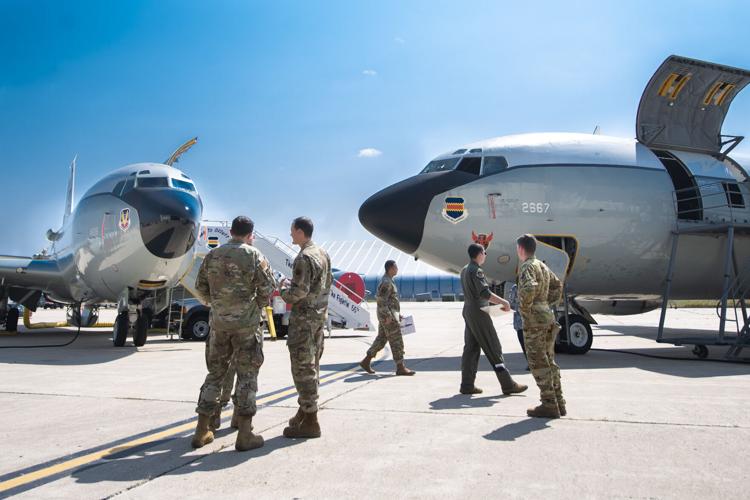
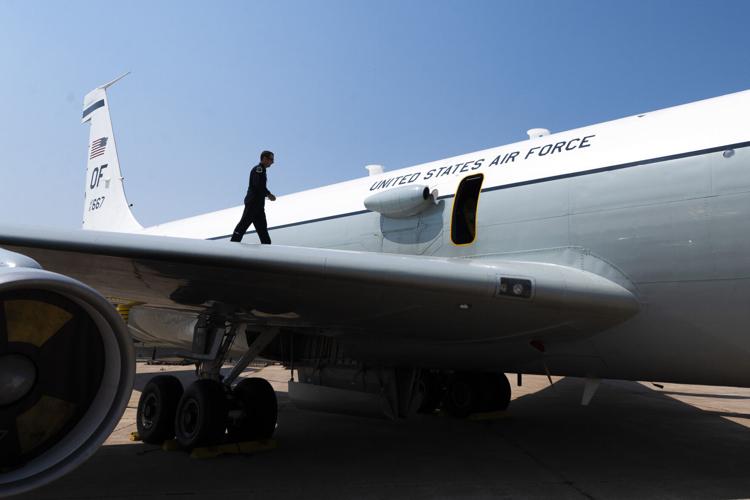
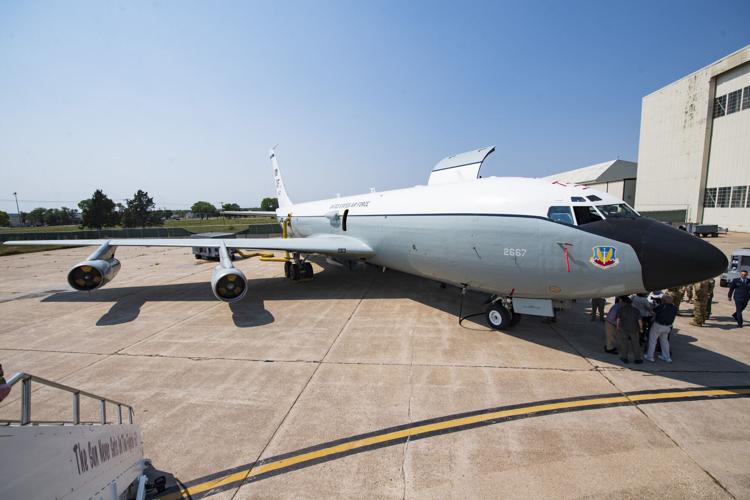
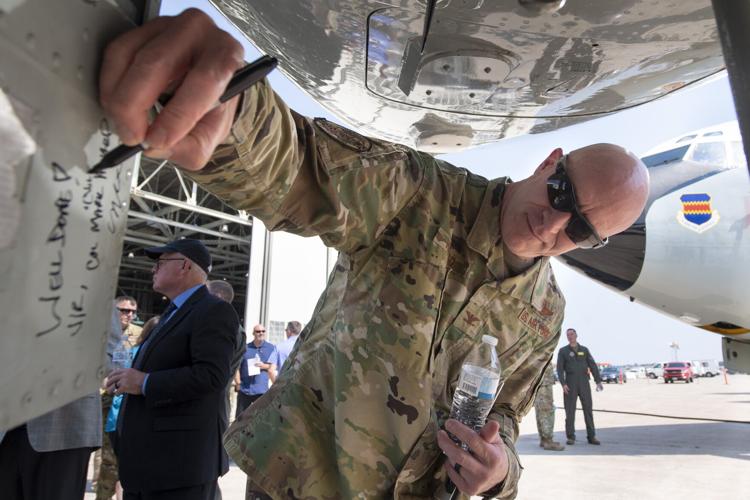
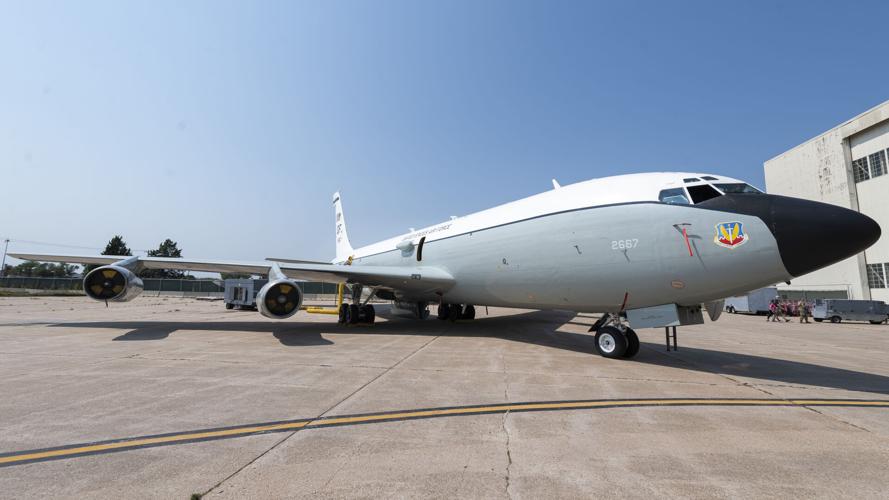
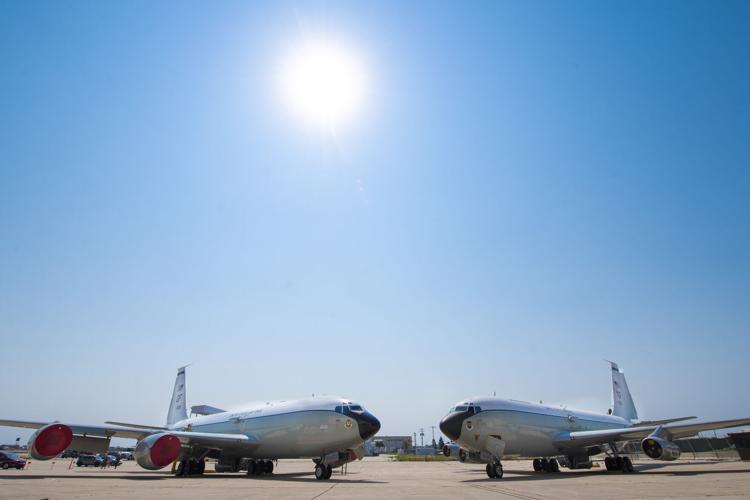
https://journalstar.com/news/local/arti ... 9bf9a.html
https://journalstar.com/news/local/arti ... 9bf9a.htmlSep 7, 2022 Updated 6 hrs ago
Out with the old, in with the new.
Such was the theme Wednesday as airmen from Offutt Air Force Base’s 55th Wing
gathered to say goodbye to the oldest WC-135 “nuke-sniffer” jet
in its fleet and welcome a (slightly) newer one.
The two planes stood nearly nose to nose in front of the Lincoln Airport hangar
that has been their temporary home
while Offutt’s runway is rebuilt.
And they provided a backdrop as those who have flown the radiation-monitoring mission, called Constant Phoenix,
paid tribute to an old workhorse jet that has served the Air Force for 60 years.
The retiring jet, tail number 61-2667, was manufactured by Boeing
and delivered to the Air Force on April 20, 1962, as a C-135B transport.
It was one of 10 converted in the mid-1960s into WC-135 weather-reconnaissance planes,
but specially configured with radiation-monitoring gear
to check international compliance of the 1963 Nuclear Test Ban Treaty.
In the decades since, 61-2667 also served for long stretches as a training aircraft.
Since 1994, it has served continuously with Offutt’s 45th Reconnaissance Squadron in the Constant Phoenix mission.
“She spent a lot of her time as a bounce bird,”
said Col. Derek Rachel, commander of the Offutt-based 55th Operations Group,
referring to the plane’s history as a trainer.
“You know she’s had a long, hard life.”
In total, 61-2667 has racked up 36,577 flight hours and 8,767 landings.
Its historic assignments included monitoring fallout after nuclear disasters at Chernobyl in 1986 and Fukushima in 2011,
as well as numerous Russian, Chinese and North Korean nuclear tests.
In the late 1990s, the WC-135 fleet dwindled to two jets as the others were scrapped or converted to other missions.
The other jet, tail number 62-3582,
was notorious for the frequent breakdowns that earned it the nickname “Lucifer’s Chariot”

from the squadron chaplain.
That plane was retired in November 2020.
“Six-Six-Seven is a lot more loved than Five-Eight-Two,” said Lt. Col. Chris Crouch,
commander of the 45th Reconnaissance Squadron.
No. 61-2667 continued its workhorse ways right into 2022.
Plane and crew traveled to RAF Mildenhall in England in January for what seemed like a routine deployment.
That deployment stretched to 5½ months — the longest Constant Phoenix deployment in recent memory —
after Russia invaded Ukraine, ratcheting up nuclear tensions in the region.
In April, they moved operations to Japan after North Korean dictator Kim Jong Un launched a series of missile tests.
“We got through it with just one jet,” Crouch said.
Still, age has taken its toll on the jet.
It was the last 55th Wing aircraft with old-fashioned analog instruments and first-generation TF-33 jet engines,
which are noisier, smokier and less fuel efficient than their modern counterparts.
Last year the plane had a “mission capable” rate of 48%, according to Air Force data published by the Air Force Times,
meaning it was capable of carrying out scheduled missions less than half the time.
And it had a “break” rate of 47%,
meaning it returned from almost half of its missions needing significant repairs.
“The parts were Eisenhower vintage,”
said Lt. Col. Sean Orme, Detachment 1 commander of the 21st Surveillance Squadron and a 10-year Constant Phoenix veteran.
“As we commonly see, they start to wear.”
All the more reason Crouch and Orme welcomed the arrival of a “new” WC-135R Constant Phoenix jet in July, tail number 64-14836.
Although the plane is just two years younger than the one it replaces,
the former New Hampshire National Guard refueling tanker
has been refurbished with “fly-by-wire” avionics and quiet, fuel-efficient engines.
“It’s a whole new jet,” Crouch said. “It’s not incrementally better, but revolutionarily better.”
Now the aircraft controls on all of the 55th Wing’s Offutt-based fleet are the same, he said.
And the motors use 40% less jet fuel, meaning air crews can fly farther without tanker support.
“There’s no place in the world isolated from this jet,” Crouch said. “It shrinks the globe.”
Capt. Jacob Schuster, a WC-135 navigator who has flown both the old plane and the new one,
said the new flight controls ease the crew’s workload.
“The automation — everything has been completely updated,” he said.
“It helps on a long-duration mission. It feels a lot easier, even if it’s a 10-hour sortie.”
The best news is yet two come. Two more refurbished WC-135Rs are slated for delivery within the next year.
And they’ll be landing on a brand-new runway at Offutt.
The 18-month reconstruction is nearly complete, and the planes are slated to return Sept. 30.
“I have a lot of excited air crew,” Crouch said.





